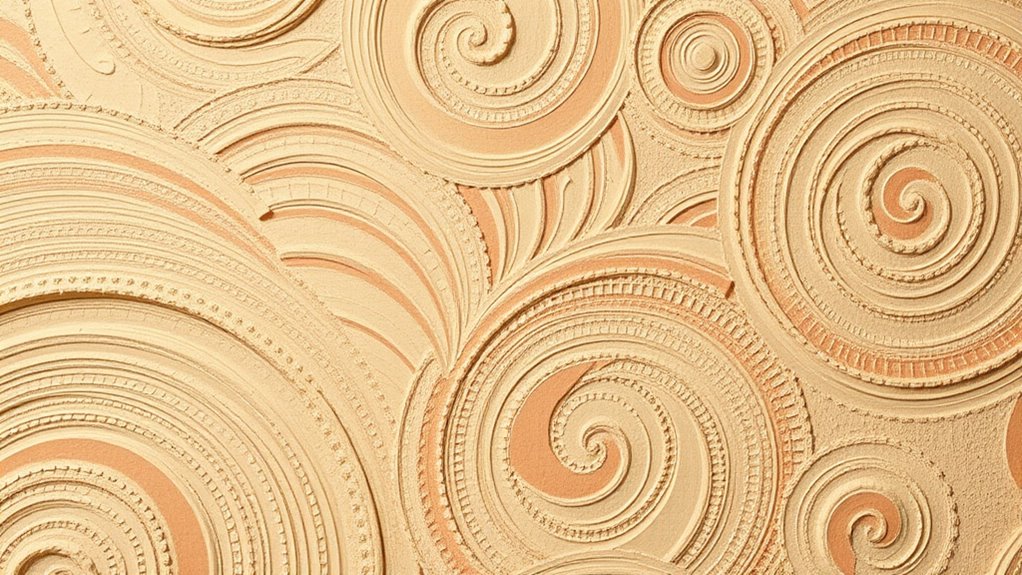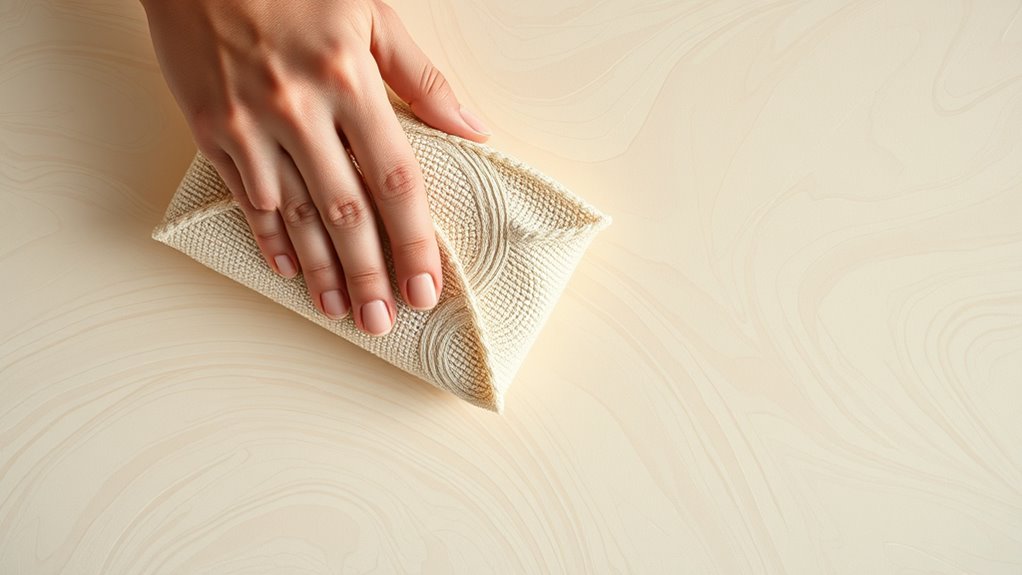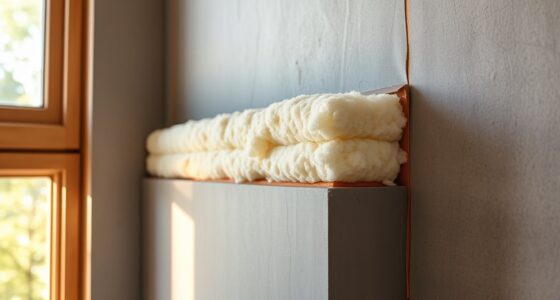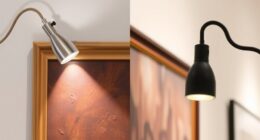Rag rolling and sponging are classic decorative finishes that add texture and depth to your walls, transforming plain surfaces into artistic focal points. With rag rolling, you use a crumpled cloth to create layered, weathered effects, while sponging offers soft, mottled textures that mimic stone or marble. Both techniques are beginner-friendly and highly customizable, allowing you to experiment with colors and patterns. Keep exploring these methods to elevate your space with unique, handcrafted appeal.
Key Takeaways
- Rag rolling and sponging are traditional faux finishing techniques that add texture and depth to walls.
- Rag rolling creates layered, weathered effects by rolling a crumpled rag over wet paint.
- Sponging produces soft, mottled patterns ideal for mimicking stone or marble surfaces.
- Both techniques enhance surface irregularities, allowing for customizable and visually appealing decor.
- These finishes are beginner-friendly, versatile, and timeless choices for transforming plain walls into artistic features.

Ever wondered how to add texture and depth to your painted surfaces? Faux finishing techniques like rag rolling and sponging are perfect for creating stunning textured walls that elevate any space. These methods bring a sense of dimension and personality to your walls, giving them a distinctive, handcrafted look. Whether you’re aiming for a subtle variation or a bold statement, mastering these techniques allows you to transform plain surfaces into works of art.
Rag rolling is a versatile technique that involves rolling a crumpled rag over wet paint to produce a textured, layered effect. It’s especially effective when you want to mimic the appearance of aged plaster or weathered fabric. To get started, choose a base color and apply it smoothly across your wall. Once it’s dry, dip a rag into a contrasting or complementary color, then blot it lightly to remove excess paint. As you roll the rag onto the wall, you’ll notice the paint catching on the creases and folds, creating a dynamic, textured pattern. You can control the pattern’s intensity by adjusting the pressure and the amount of paint on your rag. Rag rolling works beautifully on textured walls because it emphasizes the surface’s irregularities, adding depth and character with each pass.
Sponging, on the other hand, involves dabbing or stippling a sponge onto a painted surface to produce a soft, mottled effect. It’s a popular choice for faux finishing, especially when you want a subtle, cloud-like texture or a more complex layered look. To achieve this, start with a base coat and let it dry thoroughly. Then, lightly dip a natural or synthetic sponge into a contrasting paint color or glaze, squeeze out the excess, and gently dab onto the wall. Vary the pressure and the amount of paint on the sponge to create interest and depth. Sponging is particularly effective for creating faux finishes that resemble stone, marble, or textured plaster. It’s also forgiving, making it a great technique for beginners who want to experiment with textured walls without committing to a precise pattern. Incorporating faux finishing techniques can further enhance the texture and visual appeal of your walls.
Both rag rolling and sponging are excellent tools for adding visual interest and tactile appeal to your walls. They work well with various paints and finishes, and you can combine them with other faux finishing techniques for even more complex textures. The key is to work patiently, experiment with colors and pressure, and enjoy the process of creating a unique, textured surface that truly reflects your style. These classic decorative finishes are timeless for a reason—they turn simple painted walls into captivating focal points, giving your space a warm, inviting, and sophisticated feel.
Frequently Asked Questions
Can Rag Rolling or Sponging Be Done on Textured Walls?
Yes, you can rag roll or sponge on textured walls, but you need to verify texture compatibility first. Make sure the texture isn’t too rough or uneven, as it can affect the finish. Proper wall preparation is essential: clean the surface thoroughly, repair any damages, and prime if needed. This ensures your decorative finish adheres well and looks smooth, even over textured surfaces, giving your walls a fresh, stylish look.
What Types of Paint Are Best for Rag Rolling Techniques?
For rag rolling techniques, latex and acrylic paints work best because they’re durable and easy to work with. Latex paint dries quickly, allowing you to layer your finish smoothly, while acrylic offers excellent adhesion and vibrant color retention. Both types provide the flexibility you need for textured or smooth walls, ensuring your rag rolling design stays vibrant and long-lasting. Use high-quality paint for the best decorative effect.
How Do I Fix Mistakes or Uneven Patterns?
Did you know that over 60% of DIY decorators face pattern issues? To fix mistakes or uneven patterns, use touch-up techniques like gently blending or feathering the edges with a small brush. For more significant errors, carefully reapply the rag or sponge in that area, matching the existing pattern. Always wait for the paint to dry before making corrections, ensuring seamless pattern correction and a professional finish.
Are These Finishes Suitable for High-Humidity Areas?
Yes, rag rolling and sponging finishes can be suitable for high-humidity areas if you choose moisture-resistant paints and sealers. To prevent damage, guarantee proper ventilation and follow maintenance tips like cleaning with gentle solutions and inspecting for mold or peeling regularly. Using high-quality products and applying an appropriate sealant helps maintain the finish’s appearance and durability, even in humid environments.
How Long Does Each Decorative Finish Typically Last?
Rag rolling and sponging finishes usually last around 5 to 10 years, depending on your home’s conditions and maintenance. You should expect moderate durability lifespan, especially if you keep up with regular cleaning and touch-ups. These finishes are fairly low-maintenance but may need reapplication if they start to peel or fade. Proper care helps extend their appearance, ensuring your decorative wall stays beautiful and vibrant longer.
Conclusion
Rag rolling and sponging add depth, add texture, and add personality to your walls. They bring character, they create interest, and they showcase your style. With a little patience, a touch of creativity, and the right techniques, you can transform plain surfaces into stunning features. So, embrace these finishes, enjoy the process, and let your walls tell your story. Because when you add texture, you add life, and when you add life, you make your space truly yours.









